BMP4002 Business Law Assessment 2: UK Business Structures Report
VerifiedAdded on 2023/06/08
|8
|2403
|147
Report
AI Summary
This report, prepared for a Business Law assessment, examines the legal context for business organizations in the UK, with a specific focus on different business structures. It begins with an introduction to business law, including the Companies Act 2006 and the Insolvency Act 1986, and their relevance to business operations. The main body of the report provides an overview of various business structures in the UK, including sole traders, general partnerships, limited liability partnerships, and limited liability companies. Each structure is described in terms of its legal characteristics, advantages, and disadvantages. The report also offers recommendations for IOM Solutions, suggesting that the Limited Liability Company (LLC) structure would be the most suitable option for their business needs, due to its potential for growth, limited liability, and tax management benefits. The report concludes with a summary of the key findings and a list of relevant references.
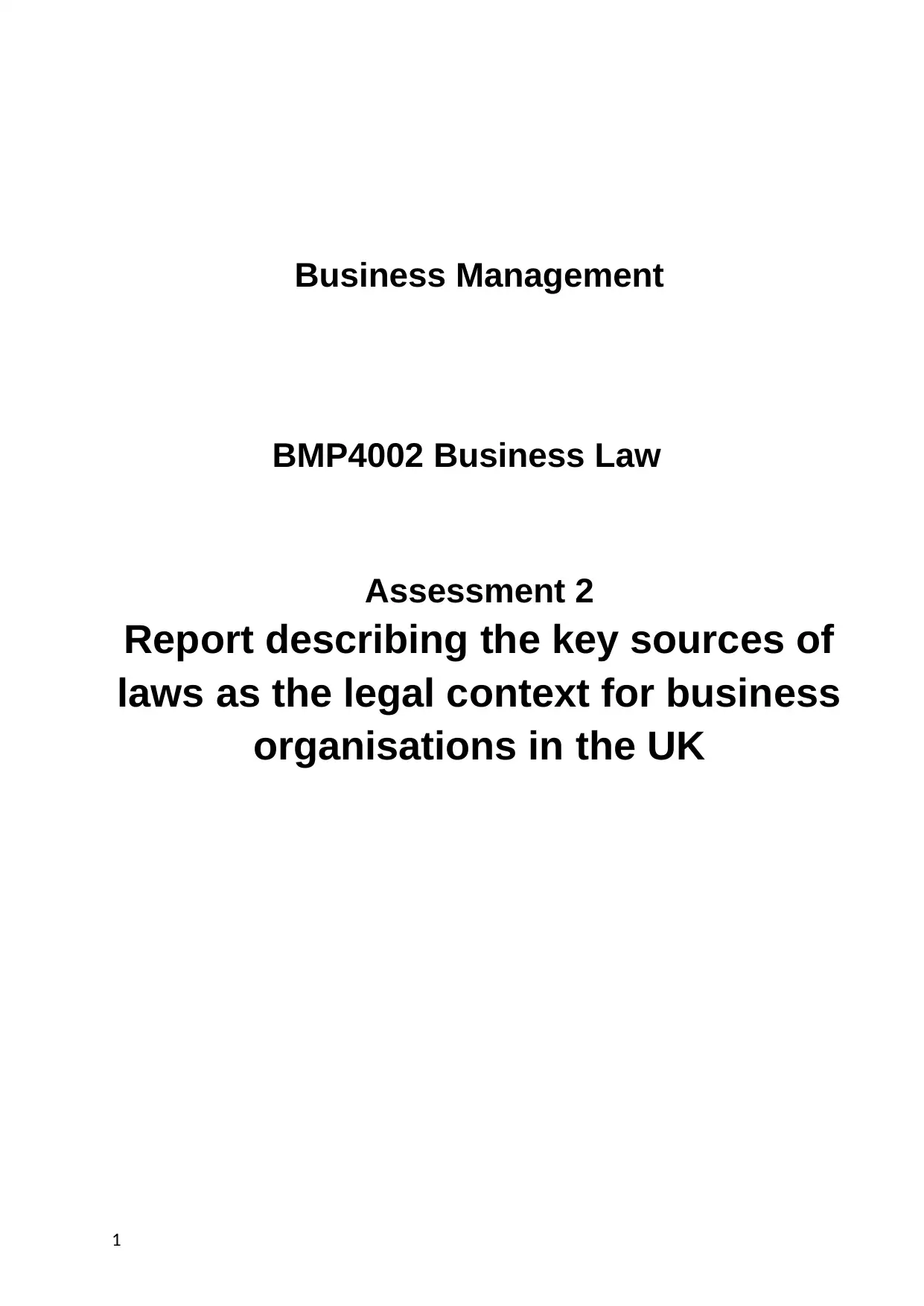
Business Management
BMP4002 Business Law
Assessment 2
Report describing the key sources of
laws as the legal context for business
organisations in the UK
1
BMP4002 Business Law
Assessment 2
Report describing the key sources of
laws as the legal context for business
organisations in the UK
1
Paraphrase This Document
Need a fresh take? Get an instant paraphrase of this document with our AI Paraphraser
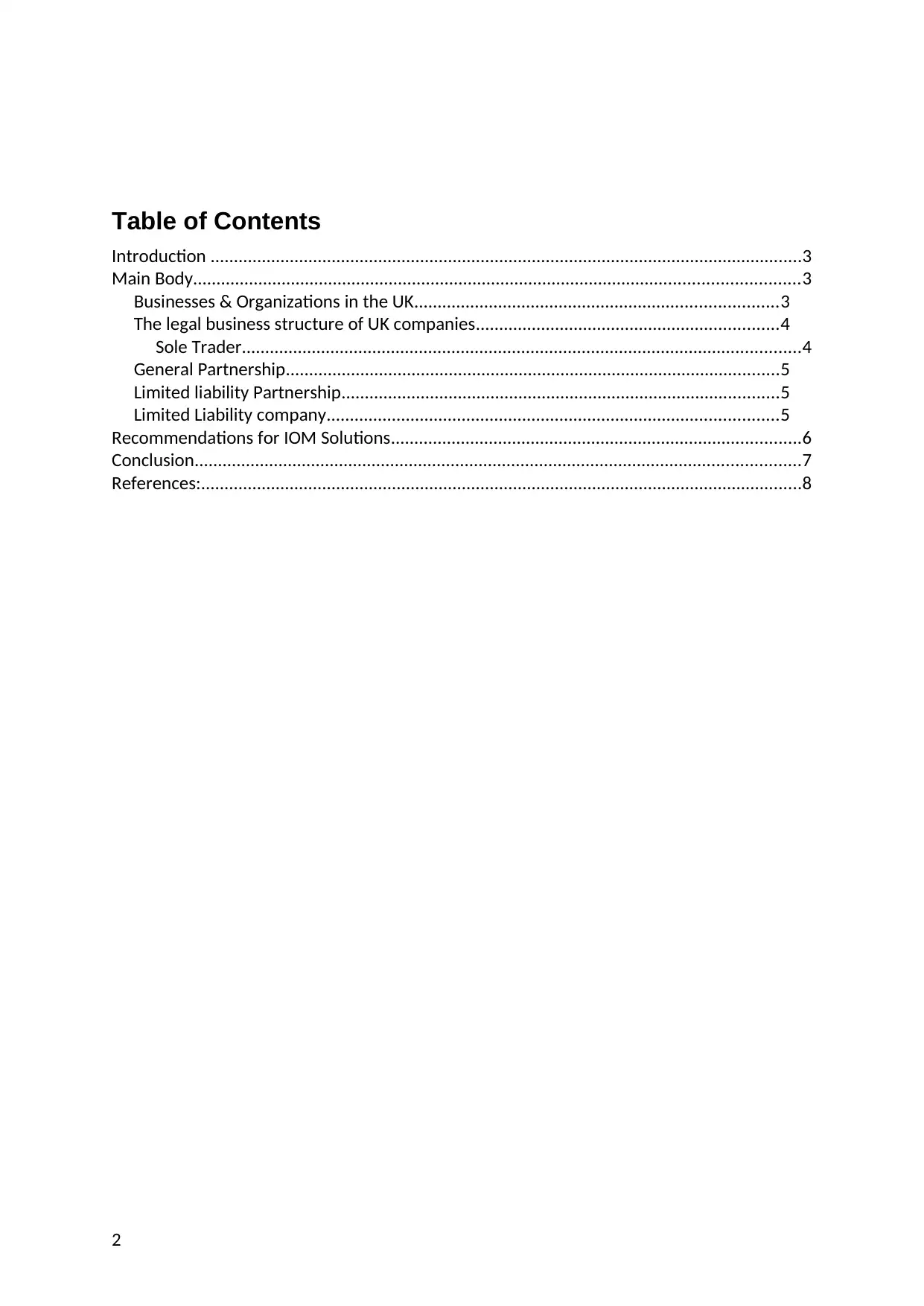
Table of Contents
Introduction ...............................................................................................................................3
Main Body..................................................................................................................................3
Businesses & Organizations in the UK..............................................................................3
The legal business structure of UK companies.................................................................4
Sole Trader........................................................................................................................4
General Partnership..........................................................................................................5
Limited liability Partnership..............................................................................................5
Limited Liability company.................................................................................................5
Recommendations for IOM Solutions........................................................................................6
Conclusion..................................................................................................................................7
References:.................................................................................................................................8
2
Introduction ...............................................................................................................................3
Main Body..................................................................................................................................3
Businesses & Organizations in the UK..............................................................................3
The legal business structure of UK companies.................................................................4
Sole Trader........................................................................................................................4
General Partnership..........................................................................................................5
Limited liability Partnership..............................................................................................5
Limited Liability company.................................................................................................5
Recommendations for IOM Solutions........................................................................................6
Conclusion..................................................................................................................................7
References:.................................................................................................................................8
2
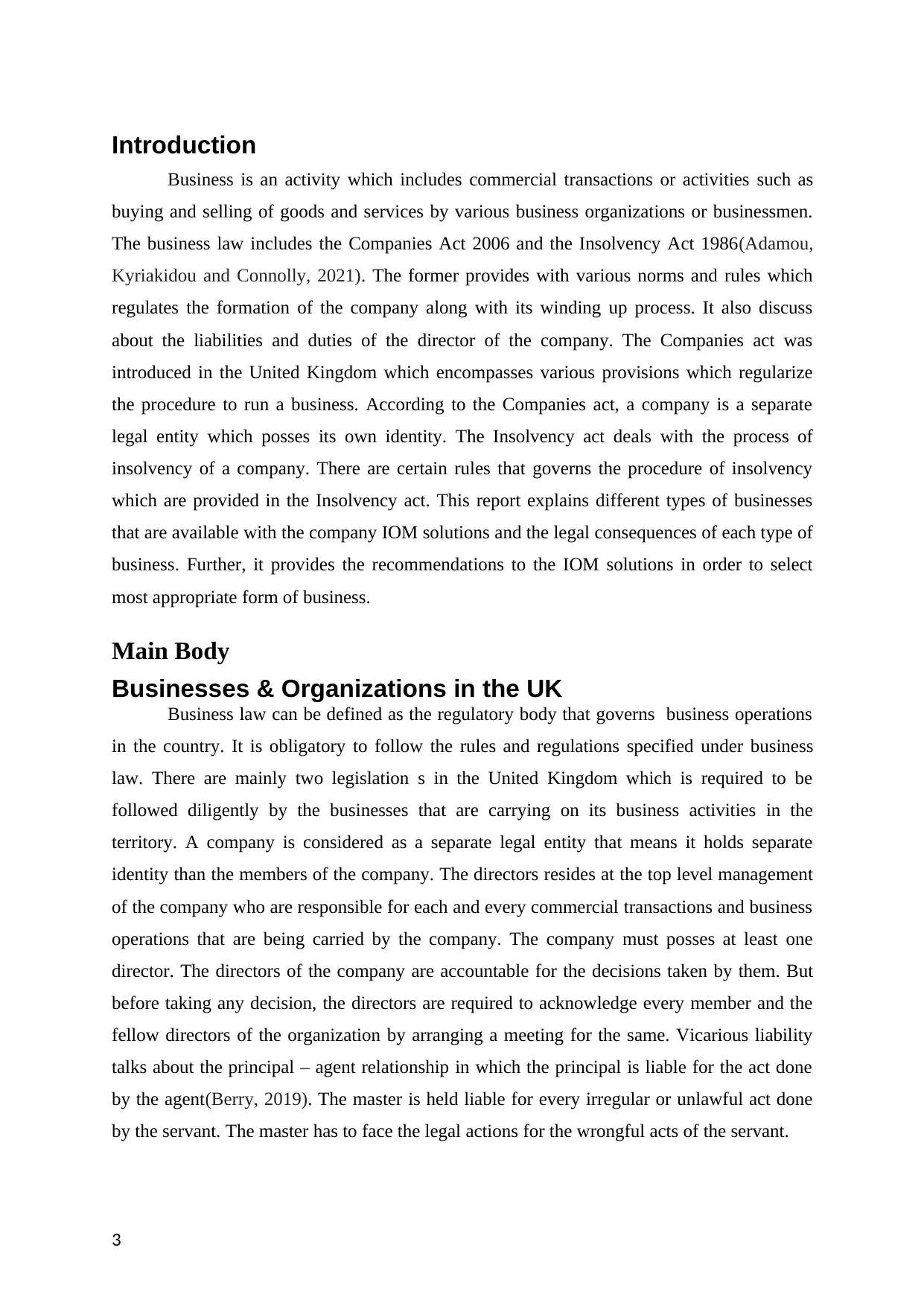
Introduction
Business is an activity which includes commercial transactions or activities such as
buying and selling of goods and services by various business organizations or businessmen.
The business law includes the Companies Act 2006 and the Insolvency Act 1986(Adamou,
Kyriakidou and Connolly, 2021). The former provides with various norms and rules which
regulates the formation of the company along with its winding up process. It also discuss
about the liabilities and duties of the director of the company. The Companies act was
introduced in the United Kingdom which encompasses various provisions which regularize
the procedure to run a business. According to the Companies act, a company is a separate
legal entity which posses its own identity. The Insolvency act deals with the process of
insolvency of a company. There are certain rules that governs the procedure of insolvency
which are provided in the Insolvency act. This report explains different types of businesses
that are available with the company IOM solutions and the legal consequences of each type of
business. Further, it provides the recommendations to the IOM solutions in order to select
most appropriate form of business.
Main Body
Businesses & Organizations in the UK
Business law can be defined as the regulatory body that governs business operations
in the country. It is obligatory to follow the rules and regulations specified under business
law. There are mainly two legislation s in the United Kingdom which is required to be
followed diligently by the businesses that are carrying on its business activities in the
territory. A company is considered as a separate legal entity that means it holds separate
identity than the members of the company. The directors resides at the top level management
of the company who are responsible for each and every commercial transactions and business
operations that are being carried by the company. The company must posses at least one
director. The directors of the company are accountable for the decisions taken by them. But
before taking any decision, the directors are required to acknowledge every member and the
fellow directors of the organization by arranging a meeting for the same. Vicarious liability
talks about the principal – agent relationship in which the principal is liable for the act done
by the agent(Berry, 2019). The master is held liable for every irregular or unlawful act done
by the servant. The master has to face the legal actions for the wrongful acts of the servant.
3
Business is an activity which includes commercial transactions or activities such as
buying and selling of goods and services by various business organizations or businessmen.
The business law includes the Companies Act 2006 and the Insolvency Act 1986(Adamou,
Kyriakidou and Connolly, 2021). The former provides with various norms and rules which
regulates the formation of the company along with its winding up process. It also discuss
about the liabilities and duties of the director of the company. The Companies act was
introduced in the United Kingdom which encompasses various provisions which regularize
the procedure to run a business. According to the Companies act, a company is a separate
legal entity which posses its own identity. The Insolvency act deals with the process of
insolvency of a company. There are certain rules that governs the procedure of insolvency
which are provided in the Insolvency act. This report explains different types of businesses
that are available with the company IOM solutions and the legal consequences of each type of
business. Further, it provides the recommendations to the IOM solutions in order to select
most appropriate form of business.
Main Body
Businesses & Organizations in the UK
Business law can be defined as the regulatory body that governs business operations
in the country. It is obligatory to follow the rules and regulations specified under business
law. There are mainly two legislation s in the United Kingdom which is required to be
followed diligently by the businesses that are carrying on its business activities in the
territory. A company is considered as a separate legal entity that means it holds separate
identity than the members of the company. The directors resides at the top level management
of the company who are responsible for each and every commercial transactions and business
operations that are being carried by the company. The company must posses at least one
director. The directors of the company are accountable for the decisions taken by them. But
before taking any decision, the directors are required to acknowledge every member and the
fellow directors of the organization by arranging a meeting for the same. Vicarious liability
talks about the principal – agent relationship in which the principal is liable for the act done
by the agent(Berry, 2019). The master is held liable for every irregular or unlawful act done
by the servant. The master has to face the legal actions for the wrongful acts of the servant.
3
⊘ This is a preview!⊘
Do you want full access?
Subscribe today to unlock all pages.

Trusted by 1+ million students worldwide
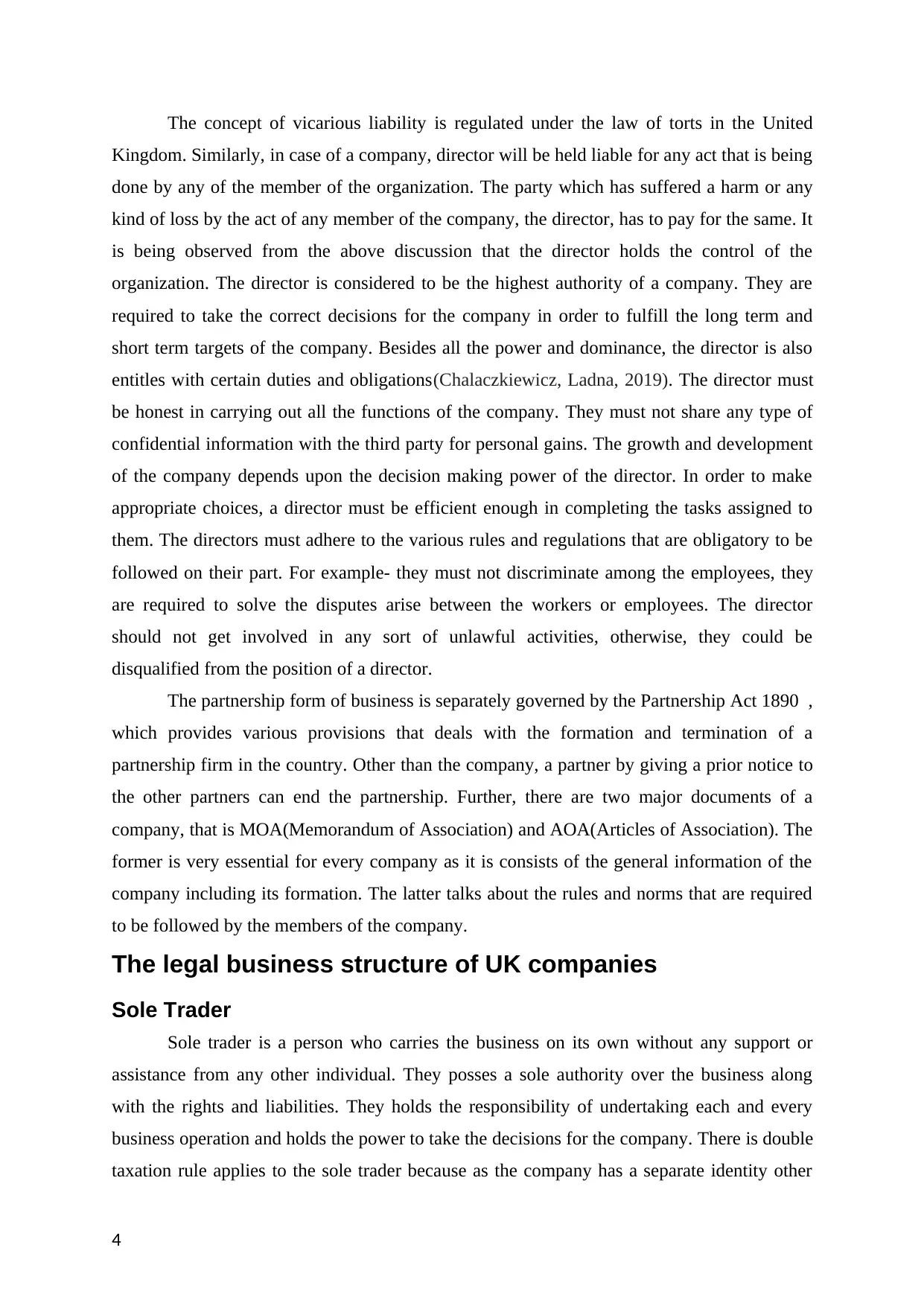
The concept of vicarious liability is regulated under the law of torts in the United
Kingdom. Similarly, in case of a company, director will be held liable for any act that is being
done by any of the member of the organization. The party which has suffered a harm or any
kind of loss by the act of any member of the company, the director, has to pay for the same. It
is being observed from the above discussion that the director holds the control of the
organization. The director is considered to be the highest authority of a company. They are
required to take the correct decisions for the company in order to fulfill the long term and
short term targets of the company. Besides all the power and dominance, the director is also
entitles with certain duties and obligations(Chalaczkiewicz, Ladna, 2019). The director must
be honest in carrying out all the functions of the company. They must not share any type of
confidential information with the third party for personal gains. The growth and development
of the company depends upon the decision making power of the director. In order to make
appropriate choices, a director must be efficient enough in completing the tasks assigned to
them. The directors must adhere to the various rules and regulations that are obligatory to be
followed on their part. For example- they must not discriminate among the employees, they
are required to solve the disputes arise between the workers or employees. The director
should not get involved in any sort of unlawful activities, otherwise, they could be
disqualified from the position of a director.
The partnership form of business is separately governed by the Partnership Act 1890 ,
which provides various provisions that deals with the formation and termination of a
partnership firm in the country. Other than the company, a partner by giving a prior notice to
the other partners can end the partnership. Further, there are two major documents of a
company, that is MOA(Memorandum of Association) and AOA(Articles of Association). The
former is very essential for every company as it is consists of the general information of the
company including its formation. The latter talks about the rules and norms that are required
to be followed by the members of the company.
The legal business structure of UK companies
Sole Trader
Sole trader is a person who carries the business on its own without any support or
assistance from any other individual. They posses a sole authority over the business along
with the rights and liabilities. They holds the responsibility of undertaking each and every
business operation and holds the power to take the decisions for the company. There is double
taxation rule applies to the sole trader because as the company has a separate identity other
4
Kingdom. Similarly, in case of a company, director will be held liable for any act that is being
done by any of the member of the organization. The party which has suffered a harm or any
kind of loss by the act of any member of the company, the director, has to pay for the same. It
is being observed from the above discussion that the director holds the control of the
organization. The director is considered to be the highest authority of a company. They are
required to take the correct decisions for the company in order to fulfill the long term and
short term targets of the company. Besides all the power and dominance, the director is also
entitles with certain duties and obligations(Chalaczkiewicz, Ladna, 2019). The director must
be honest in carrying out all the functions of the company. They must not share any type of
confidential information with the third party for personal gains. The growth and development
of the company depends upon the decision making power of the director. In order to make
appropriate choices, a director must be efficient enough in completing the tasks assigned to
them. The directors must adhere to the various rules and regulations that are obligatory to be
followed on their part. For example- they must not discriminate among the employees, they
are required to solve the disputes arise between the workers or employees. The director
should not get involved in any sort of unlawful activities, otherwise, they could be
disqualified from the position of a director.
The partnership form of business is separately governed by the Partnership Act 1890 ,
which provides various provisions that deals with the formation and termination of a
partnership firm in the country. Other than the company, a partner by giving a prior notice to
the other partners can end the partnership. Further, there are two major documents of a
company, that is MOA(Memorandum of Association) and AOA(Articles of Association). The
former is very essential for every company as it is consists of the general information of the
company including its formation. The latter talks about the rules and norms that are required
to be followed by the members of the company.
The legal business structure of UK companies
Sole Trader
Sole trader is a person who carries the business on its own without any support or
assistance from any other individual. They posses a sole authority over the business along
with the rights and liabilities. They holds the responsibility of undertaking each and every
business operation and holds the power to take the decisions for the company. There is double
taxation rule applies to the sole trader because as the company has a separate identity other
4
Paraphrase This Document
Need a fresh take? Get an instant paraphrase of this document with our AI Paraphraser
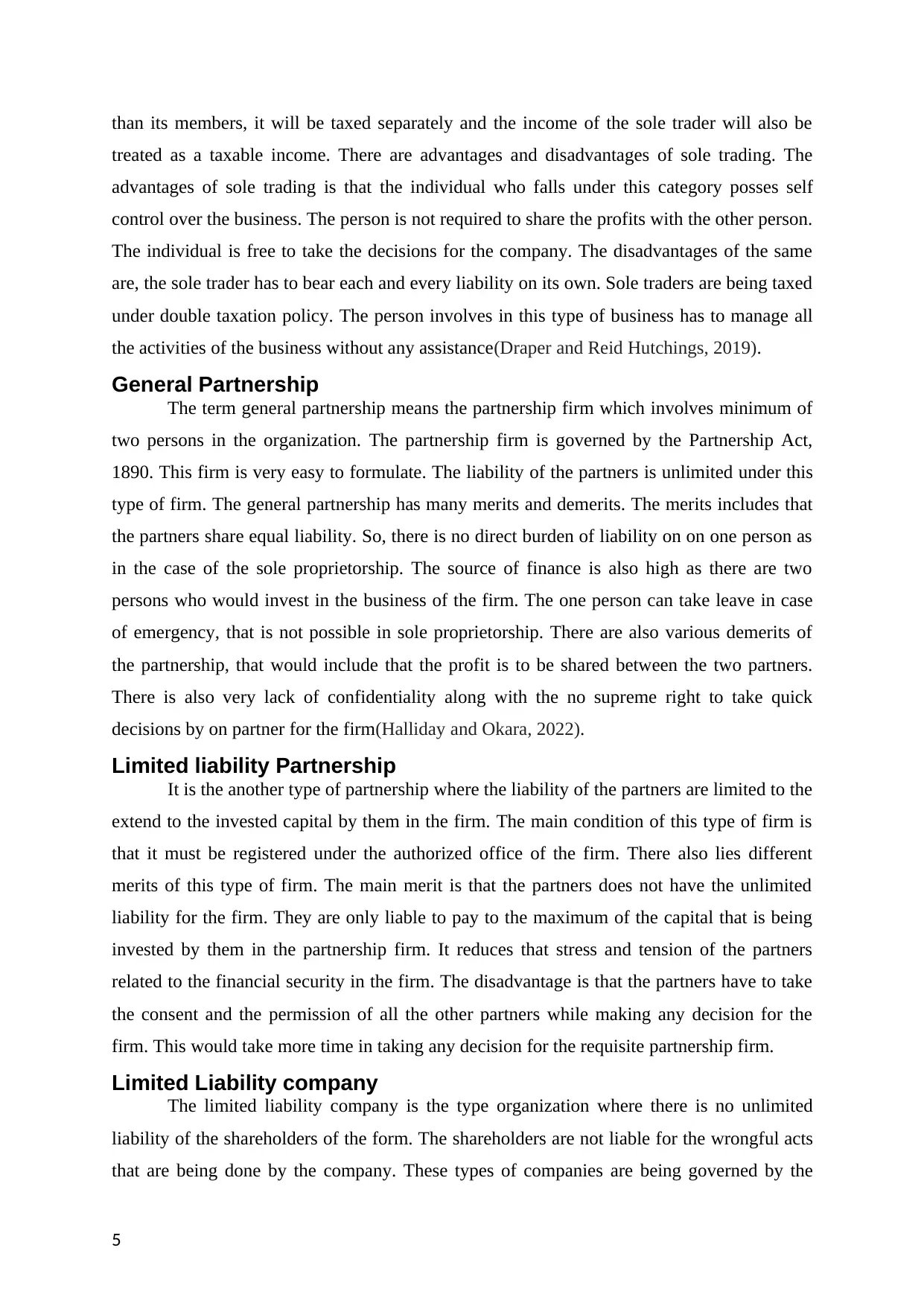
than its members, it will be taxed separately and the income of the sole trader will also be
treated as a taxable income. There are advantages and disadvantages of sole trading. The
advantages of sole trading is that the individual who falls under this category posses self
control over the business. The person is not required to share the profits with the other person.
The individual is free to take the decisions for the company. The disadvantages of the same
are, the sole trader has to bear each and every liability on its own. Sole traders are being taxed
under double taxation policy. The person involves in this type of business has to manage all
the activities of the business without any assistance(Draper and Reid Hutchings, 2019).
General Partnership
The term general partnership means the partnership firm which involves minimum of
two persons in the organization. The partnership firm is governed by the Partnership Act,
1890. This firm is very easy to formulate. The liability of the partners is unlimited under this
type of firm. The general partnership has many merits and demerits. The merits includes that
the partners share equal liability. So, there is no direct burden of liability on on one person as
in the case of the sole proprietorship. The source of finance is also high as there are two
persons who would invest in the business of the firm. The one person can take leave in case
of emergency, that is not possible in sole proprietorship. There are also various demerits of
the partnership, that would include that the profit is to be shared between the two partners.
There is also very lack of confidentiality along with the no supreme right to take quick
decisions by on partner for the firm(Halliday and Okara, 2022).
Limited liability Partnership
It is the another type of partnership where the liability of the partners are limited to the
extend to the invested capital by them in the firm. The main condition of this type of firm is
that it must be registered under the authorized office of the firm. There also lies different
merits of this type of firm. The main merit is that the partners does not have the unlimited
liability for the firm. They are only liable to pay to the maximum of the capital that is being
invested by them in the partnership firm. It reduces that stress and tension of the partners
related to the financial security in the firm. The disadvantage is that the partners have to take
the consent and the permission of all the other partners while making any decision for the
firm. This would take more time in taking any decision for the requisite partnership firm.
Limited Liability company
The limited liability company is the type organization where there is no unlimited
liability of the shareholders of the form. The shareholders are not liable for the wrongful acts
that are being done by the company. These types of companies are being governed by the
5
treated as a taxable income. There are advantages and disadvantages of sole trading. The
advantages of sole trading is that the individual who falls under this category posses self
control over the business. The person is not required to share the profits with the other person.
The individual is free to take the decisions for the company. The disadvantages of the same
are, the sole trader has to bear each and every liability on its own. Sole traders are being taxed
under double taxation policy. The person involves in this type of business has to manage all
the activities of the business without any assistance(Draper and Reid Hutchings, 2019).
General Partnership
The term general partnership means the partnership firm which involves minimum of
two persons in the organization. The partnership firm is governed by the Partnership Act,
1890. This firm is very easy to formulate. The liability of the partners is unlimited under this
type of firm. The general partnership has many merits and demerits. The merits includes that
the partners share equal liability. So, there is no direct burden of liability on on one person as
in the case of the sole proprietorship. The source of finance is also high as there are two
persons who would invest in the business of the firm. The one person can take leave in case
of emergency, that is not possible in sole proprietorship. There are also various demerits of
the partnership, that would include that the profit is to be shared between the two partners.
There is also very lack of confidentiality along with the no supreme right to take quick
decisions by on partner for the firm(Halliday and Okara, 2022).
Limited liability Partnership
It is the another type of partnership where the liability of the partners are limited to the
extend to the invested capital by them in the firm. The main condition of this type of firm is
that it must be registered under the authorized office of the firm. There also lies different
merits of this type of firm. The main merit is that the partners does not have the unlimited
liability for the firm. They are only liable to pay to the maximum of the capital that is being
invested by them in the partnership firm. It reduces that stress and tension of the partners
related to the financial security in the firm. The disadvantage is that the partners have to take
the consent and the permission of all the other partners while making any decision for the
firm. This would take more time in taking any decision for the requisite partnership firm.
Limited Liability company
The limited liability company is the type organization where there is no unlimited
liability of the shareholders of the form. The shareholders are not liable for the wrongful acts
that are being done by the company. These types of companies are being governed by the
5
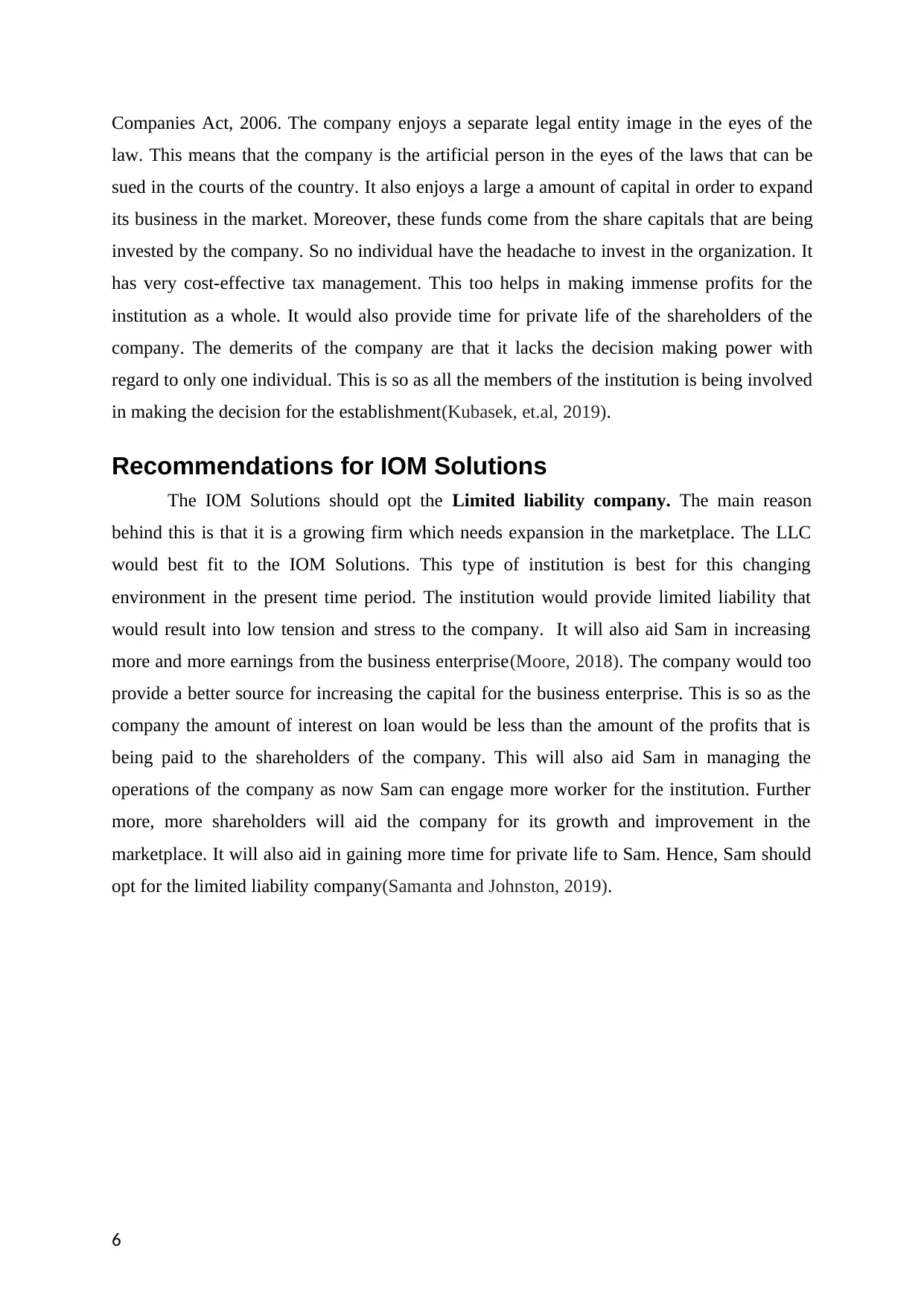
Companies Act, 2006. The company enjoys a separate legal entity image in the eyes of the
law. This means that the company is the artificial person in the eyes of the laws that can be
sued in the courts of the country. It also enjoys a large a amount of capital in order to expand
its business in the market. Moreover, these funds come from the share capitals that are being
invested by the company. So no individual have the headache to invest in the organization. It
has very cost-effective tax management. This too helps in making immense profits for the
institution as a whole. It would also provide time for private life of the shareholders of the
company. The demerits of the company are that it lacks the decision making power with
regard to only one individual. This is so as all the members of the institution is being involved
in making the decision for the establishment(Kubasek, et.al, 2019).
Recommendations for IOM Solutions
The IOM Solutions should opt the Limited liability company. The main reason
behind this is that it is a growing firm which needs expansion in the marketplace. The LLC
would best fit to the IOM Solutions. This type of institution is best for this changing
environment in the present time period. The institution would provide limited liability that
would result into low tension and stress to the company. It will also aid Sam in increasing
more and more earnings from the business enterprise(Moore, 2018). The company would too
provide a better source for increasing the capital for the business enterprise. This is so as the
company the amount of interest on loan would be less than the amount of the profits that is
being paid to the shareholders of the company. This will also aid Sam in managing the
operations of the company as now Sam can engage more worker for the institution. Further
more, more shareholders will aid the company for its growth and improvement in the
marketplace. It will also aid in gaining more time for private life to Sam. Hence, Sam should
opt for the limited liability company(Samanta and Johnston, 2019).
6
law. This means that the company is the artificial person in the eyes of the laws that can be
sued in the courts of the country. It also enjoys a large a amount of capital in order to expand
its business in the market. Moreover, these funds come from the share capitals that are being
invested by the company. So no individual have the headache to invest in the organization. It
has very cost-effective tax management. This too helps in making immense profits for the
institution as a whole. It would also provide time for private life of the shareholders of the
company. The demerits of the company are that it lacks the decision making power with
regard to only one individual. This is so as all the members of the institution is being involved
in making the decision for the establishment(Kubasek, et.al, 2019).
Recommendations for IOM Solutions
The IOM Solutions should opt the Limited liability company. The main reason
behind this is that it is a growing firm which needs expansion in the marketplace. The LLC
would best fit to the IOM Solutions. This type of institution is best for this changing
environment in the present time period. The institution would provide limited liability that
would result into low tension and stress to the company. It will also aid Sam in increasing
more and more earnings from the business enterprise(Moore, 2018). The company would too
provide a better source for increasing the capital for the business enterprise. This is so as the
company the amount of interest on loan would be less than the amount of the profits that is
being paid to the shareholders of the company. This will also aid Sam in managing the
operations of the company as now Sam can engage more worker for the institution. Further
more, more shareholders will aid the company for its growth and improvement in the
marketplace. It will also aid in gaining more time for private life to Sam. Hence, Sam should
opt for the limited liability company(Samanta and Johnston, 2019).
6
⊘ This is a preview!⊘
Do you want full access?
Subscribe today to unlock all pages.

Trusted by 1+ million students worldwide
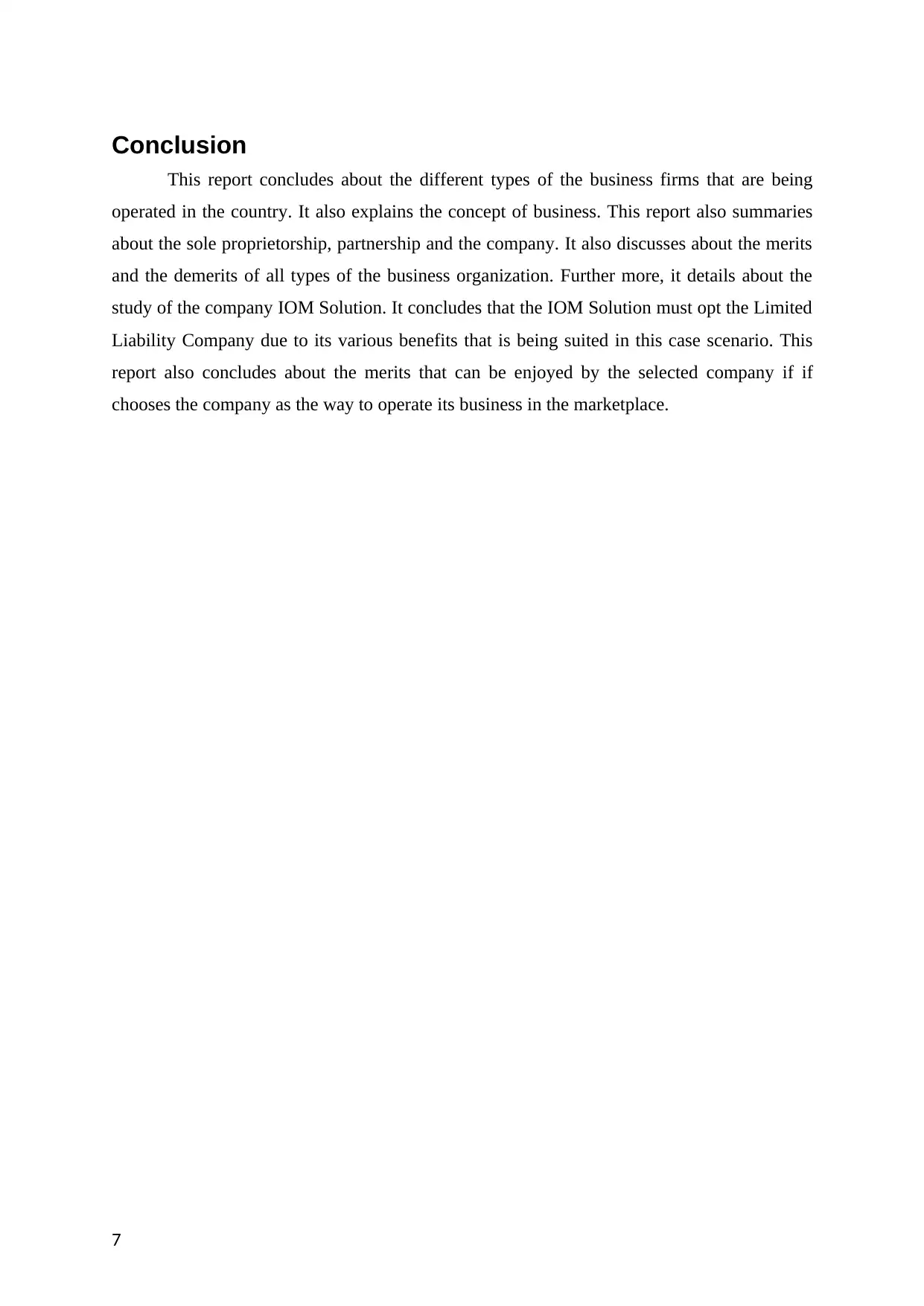
Conclusion
This report concludes about the different types of the business firms that are being
operated in the country. It also explains the concept of business. This report also summaries
about the sole proprietorship, partnership and the company. It also discusses about the merits
and the demerits of all types of the business organization. Further more, it details about the
study of the company IOM Solution. It concludes that the IOM Solution must opt the Limited
Liability Company due to its various benefits that is being suited in this case scenario. This
report also concludes about the merits that can be enjoyed by the selected company if if
chooses the company as the way to operate its business in the marketplace.
7
This report concludes about the different types of the business firms that are being
operated in the country. It also explains the concept of business. This report also summaries
about the sole proprietorship, partnership and the company. It also discusses about the merits
and the demerits of all types of the business organization. Further more, it details about the
study of the company IOM Solution. It concludes that the IOM Solution must opt the Limited
Liability Company due to its various benefits that is being suited in this case scenario. This
report also concludes about the merits that can be enjoyed by the selected company if if
chooses the company as the way to operate its business in the marketplace.
7
Paraphrase This Document
Need a fresh take? Get an instant paraphrase of this document with our AI Paraphraser
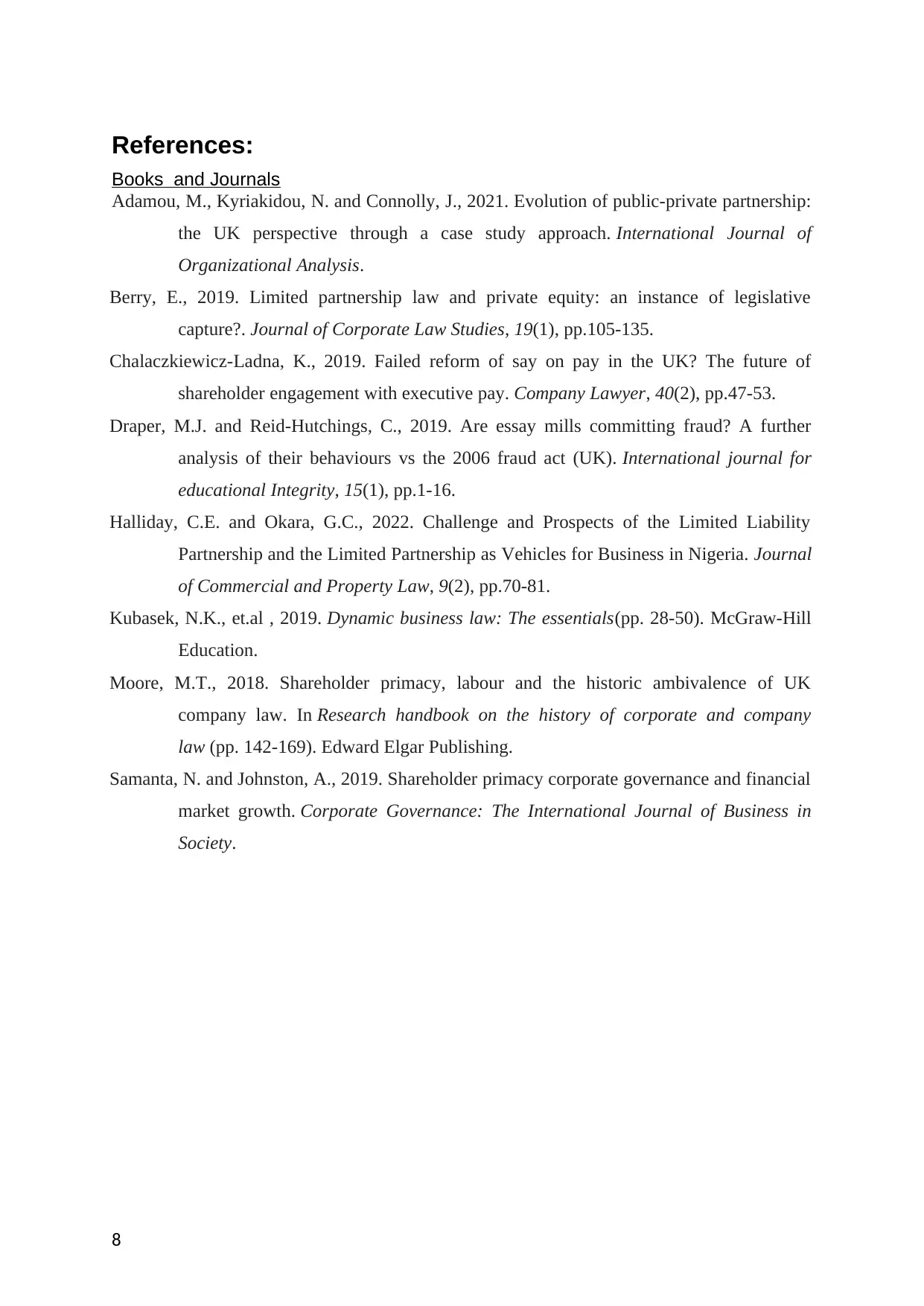
References:
Books and Journals
Adamou, M., Kyriakidou, N. and Connolly, J., 2021. Evolution of public-private partnership:
the UK perspective through a case study approach. International Journal of
Organizational Analysis.
Berry, E., 2019. Limited partnership law and private equity: an instance of legislative
capture?. Journal of Corporate Law Studies, 19(1), pp.105-135.
Chalaczkiewicz-Ladna, K., 2019. Failed reform of say on pay in the UK? The future of
shareholder engagement with executive pay. Company Lawyer, 40(2), pp.47-53.
Draper, M.J. and Reid-Hutchings, C., 2019. Are essay mills committing fraud? A further
analysis of their behaviours vs the 2006 fraud act (UK). International journal for
educational Integrity, 15(1), pp.1-16.
Halliday, C.E. and Okara, G.C., 2022. Challenge and Prospects of the Limited Liability
Partnership and the Limited Partnership as Vehicles for Business in Nigeria. Journal
of Commercial and Property Law, 9(2), pp.70-81.
Kubasek, N.K., et.al , 2019. Dynamic business law: The essentials(pp. 28-50). McGraw-Hill
Education.
Moore, M.T., 2018. Shareholder primacy, labour and the historic ambivalence of UK
company law. In Research handbook on the history of corporate and company
law (pp. 142-169). Edward Elgar Publishing.
Samanta, N. and Johnston, A., 2019. Shareholder primacy corporate governance and financial
market growth. Corporate Governance: The International Journal of Business in
Society.
8
Books and Journals
Adamou, M., Kyriakidou, N. and Connolly, J., 2021. Evolution of public-private partnership:
the UK perspective through a case study approach. International Journal of
Organizational Analysis.
Berry, E., 2019. Limited partnership law and private equity: an instance of legislative
capture?. Journal of Corporate Law Studies, 19(1), pp.105-135.
Chalaczkiewicz-Ladna, K., 2019. Failed reform of say on pay in the UK? The future of
shareholder engagement with executive pay. Company Lawyer, 40(2), pp.47-53.
Draper, M.J. and Reid-Hutchings, C., 2019. Are essay mills committing fraud? A further
analysis of their behaviours vs the 2006 fraud act (UK). International journal for
educational Integrity, 15(1), pp.1-16.
Halliday, C.E. and Okara, G.C., 2022. Challenge and Prospects of the Limited Liability
Partnership and the Limited Partnership as Vehicles for Business in Nigeria. Journal
of Commercial and Property Law, 9(2), pp.70-81.
Kubasek, N.K., et.al , 2019. Dynamic business law: The essentials(pp. 28-50). McGraw-Hill
Education.
Moore, M.T., 2018. Shareholder primacy, labour and the historic ambivalence of UK
company law. In Research handbook on the history of corporate and company
law (pp. 142-169). Edward Elgar Publishing.
Samanta, N. and Johnston, A., 2019. Shareholder primacy corporate governance and financial
market growth. Corporate Governance: The International Journal of Business in
Society.
8
1 out of 8
Related Documents
Your All-in-One AI-Powered Toolkit for Academic Success.
+13062052269
info@desklib.com
Available 24*7 on WhatsApp / Email
![[object Object]](/_next/static/media/star-bottom.7253800d.svg)
Unlock your academic potential
Copyright © 2020–2025 A2Z Services. All Rights Reserved. Developed and managed by ZUCOL.

